Fans of old can give a knowing nod, whispering “Joseph,” as the red rubber ball bounces back out of the dusty attic and onto a special limited edition Blu-ray of Peter Medak’s The Changeling by Severin Films. I specify the director to help distinguish from Clint Eastwood’s 2008 film Changeling starring Angelina Jolie. This is certainly not that film nor is it author Victor LaValle’s The Changeling, which recently became a finalist for the World Fantasy Award, but they each dabble in a unique film and literary double indicated by their titles, which will be addressed below. Severin Films was able to officially announce that they were releasing the limited edition Blu-ray on June 6th, 2018. To date, the film has not been available to stream, and as further stated by Severin Films’ website, this is “the 1980 horror classic fully restored in HD for the first time ever in America.”[1] For those who prefer specifics, the site goes on to explain the transfer as “a new HD transfer created from a 4K scan of the inter-positive film element.” I would like to continue staging this with some further quotes and a personal anecdote.
In the mid-1990s, it was well-known among teenagers in Abilene, TX, where I grew up, that every October the historic Paramount Theater downtown screened The Changeling two nights only for Halloween. The tradition of the film’s screening continued as best I can tell through 2006. According to an issue of Abilene Christian University’s student paper The Optimist from October 26, 2006, “The Paramount Theater will show its yearly scary movie feature The Changeling starring George C. Scott … Barry Smoot, artistic director of the Paramount, said he expects about 500 people to watch the Halloween presentation. ‘We’ve been showing this movie for years now, so it has become somewhat of a tradition,’ Smoot said.”[1] It appears that in the past few years those screenings have transitioned to more family-friendly fare such as Beetlejuice and Hocus Pocus, though I do see a screening of Carrie dating to 2011. In 1996, my experience with horror films was somewhat limited, even at the age of sixteen. I had, of course, grown up with edited-for-TV screenings of the Nightmare on Elm Street series, seen the Friday the 13th series through HBO at a friend’s house, and even a sneaked-in viewing of Stephen King’s limited television movie IT. Maybe I had begun to explore a bit more at that time, honestly, but my solitary viewing of The Changeling at the Paramount Theater was my first psychological ghost story, one that avoided the slasher tropes of my horror education up to that point.
It burrowed into my thoughts. As a fact, I remember having to pull over driving home from excited and frightened shaking. Once a horror fan experiences a reaction like that, we spend the rest of our lives trying to find films that recreate that exact feeling. That said, I credit it as the film that finally guided me toward films like The Exorcist I & III and The Shining and onward from there. In a cursory search, I’m happy to see I was not alone. According to an October 15, 2016 post on Minced Meat Pie, one “Nerd Herder” claims The Changeling at number five on their top five Halloween movies, explaining “I saw this film for the first time at a sold-out Paramount Theatre in Abilene, TX on Halloween back in 1992. I had no clue as to what I was walking into other than it was a haunted house film. As the lights dimmed and the film reel rolled, screams from the audience quickly made me question, how in the hell did I let this movie slip under my radar? I never had heard of it until this showing and I had thought I had seen every horror film at our local video store. Catalog fail!”[2] In a less obvious reporting venue, one Brazman writes on the Texas Bow Hunter forum—I cannot make this stuff up—“The Changeling (with George C. Scott) is a classic ghost horror movie, and really messed me up. Also at the Paramount, also in high school.”[3] For those who did not live through the tradition, this Blu-ray release will introduce many to the film and hopefully initiate some new Halloween traditions of your own.
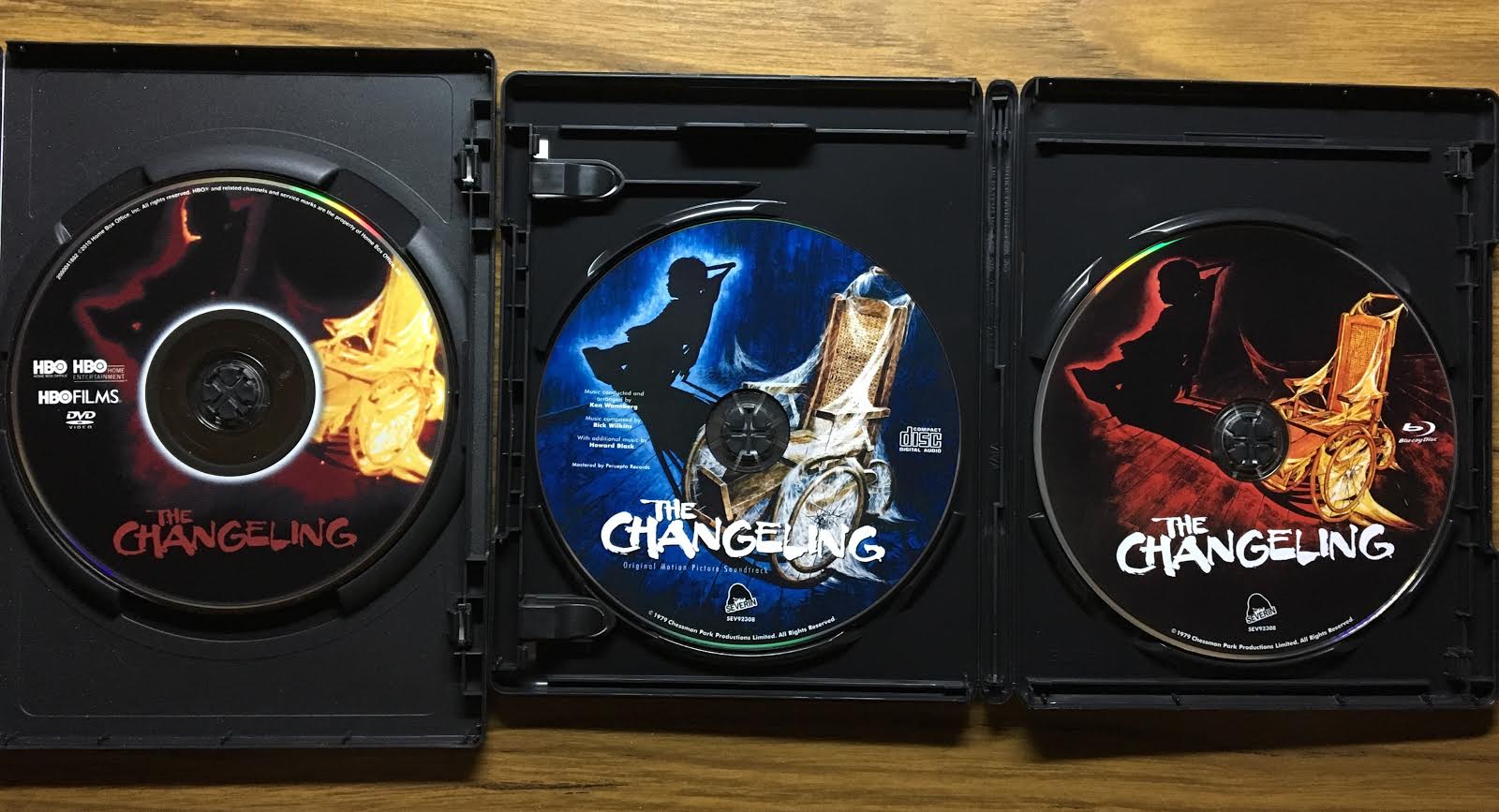
Severin Films’ release has a lot to boast. Those of us in the U.S. (note that these editions are region free) will be getting audio commentary for the first time ever by director Peter Medak and producer Joel B. Michaels, interviews with Music Arranger Kenneth Wannberg and Art Director Reuben Freed, as well as featurettes, trailers, and TV spots. The concurrently released edition in the UK by Second Sight will include the majority of these same features with the addition of a 40-page booklet. According to Eric Contenas of DVD Drive-in, there has been a UK and Germany release by Studio Canal since 2000 which included previous commentary by Medak but which was replaced in this edition for a new commentary by the director and producer Joel B. Michaels. An early limited bundle sold directly from Severin Films includes the Blu-ray with the soundtrack on CD, a slipcover, an 18 x 24 limited edition numbered poster, replica red ball, and an enamel pin. The website states that “This bundle expires when all 300 posters are sold.” As of this portion of my writing (July 7, 2018), it is currently listed as out of stock. Other offered bundles will continue to include some of these limited items until sold out. The stand-alone Blu-ray will remain available. Given all of this—special features, sold out editions, theater traditions—it almost gives the impression that everyone would have seen this film. This is not true. In fact, while Martin Scorsese has claimed it as “One of the scariest films of all time,” it has not been traditionally revered. A look at early reviews tells us as much.
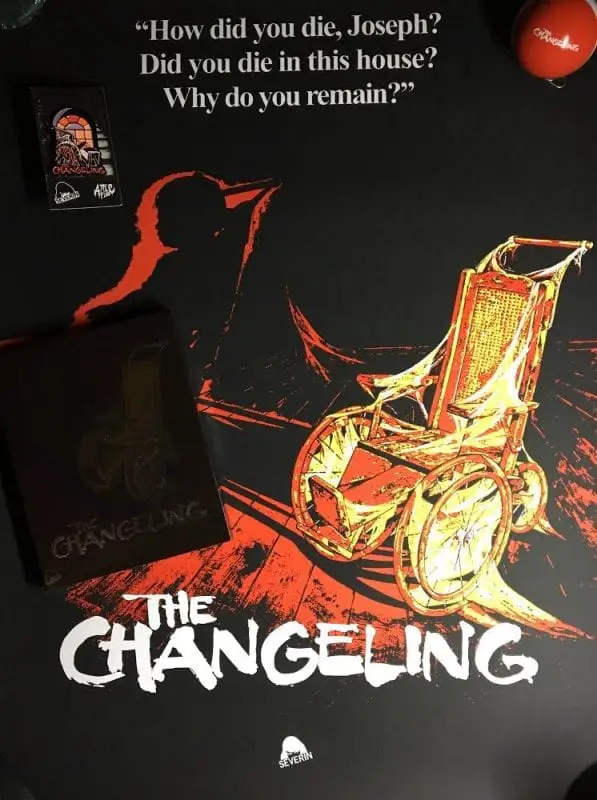
In a review by film critic Canby Vincent for the New York Times, he admits that “It’s seriously acted by George C. Scott …” and that “The film has also been seriously directed by Peter Medak … in some handsome settings in Seattle and Vancouver, British Columbia, with seriously expensive, complicated supernatural effects. Yet “The Changeling” is nothing more than seriously silly.”[4] Between critics upon its release, there seems to be a desire to laud the film for its “seriousness” but hesitancy to leave it there without admonishment. Roger Ebert found the same difficulty leveling his feelings on the film.
Medak is a little too fond of wide-angle shots (his choice of lenses makes all the rooms look wraparound), but he takes a good, basic approach to the haunting phenomena. This is a scare movie with taste. And yet, halfway through the movie, admiring the craft of the séance scene, I found myself wondering why I didn’t really care what happened. And, as an admirer of George C. Scott’s acting, I found myself thinking the unthinkable: That Scott wasn’t creating a character I was really worried about.[5]
These are fair assessments, though I might argue that as a depressed character, Scott’s Russell is a character that would have been every bit as detached and impassive as Ebert suggests. The scares remain intact, though, and films with such reviews have been fortunate. As access has been increased with Blu-ray restorations such as Severin Films’ and Scream & Shout! Factories’ releases as well as wide-releases through streaming platforms, they have seen reappraisal. In 2012, IFC aired the film asking the question “Is ‘The Changeling’ the scariest movie ever?”[6] So, what does the film bring for the newly initiated, and what does the feature-packed Blu-ray give us?

First, it is a haunted house film, yes, but then, no, it’s a ghost story. Perhaps it is both. In his introduction to Robert Marasco’s haunted house novel Burnt Offerings, author Stephen Graham Jones explains two kinds of haunted house stories—the “Stay Away” kind and the “Hungry House.” Early signs in The Changeling would indicate that this is a Stay Away house into which composer John Russell has moved. He has found the house with its grandiose music room and Victorian spaciousness as a getaway from the pain of the tragedy he experienced in losing his daughter and wife in an icy wreck. A piano depresses its own keys when no-one is present, doors open themselves, and thunderous knocking resounds on the pipes at the same time every morning as John’s memories of the wreck haunt his dreams. So the statement in Jones’s introduction that sticks out is that “A Hungry House knows the injuries you’ve been nursing in secret, and it uses them against you.”[7] In this case, a ghost sees something in John.
Spoiler Content below:
In the climax of the film, the revelatory moment, John allows for a séance in his home to find out once and for all what the ghost inhabiting his new home wants, perhaps how he can help, even. That ghost is Joseph, an invalid child, ambiguously seeking either justice or revenge for his wrongs. Still, he is inextricably tied to the bones of the house. As Jason Dorwart explains in his dissertation “The Incorporeal Corpse: Disability, Liminality, Performance,” the disabled spirit haunts us from the film’s cover.
… any cinephile who has spent an evening looking through the horror section of the movie rental store would have an immediate recognition and reaction to the empty wheelchair on the film’s poster and DVD box cover. … The film’s promotional materials inform us ahead of time that the threat of disability will be present throughout the film and that this disability is linked to ghostlyness and to death. We want to know who was in that wheelchair? Why is the dead body still attempting to occupy the wheelchair? And who will end up in that wheelchair?[8]

I will not unveil the whole of the mystery in this article but suffice it to say, Joseph seeks the changeling. And what is a changeling? Succinctly, “infants switched at birth” best defines the situation, though I suspect the changeling definition might be stretched to include other situations. 25YL often covers Twin Peaks, a series full of others, doubles, and doppelgangers, but in this film, we are presented with the lesser obvious double in these changelings. It is a convention likely more used in comic books, wherein a villain might trap or believe a foil dead while they brazenly tirade, destroying the life of the captured as an undetected imposter. Author Pilar Andrade offers us some more examples of their usage in the following passage.
A variation of supplanting might be the changeling, which in West European folklore occurred when the offspring of a fairy, troll, elf, or other legendary creature that has been secretly left in the place of a human child. A well-known example occurs in Shakespeare’s A Midsummer Night’s Dream, where Titania and Oberon are fighting over the possession of a changeling boy, and because of their argument, nature is in upheaval, and all the subsequent action of the plot ensues. Other examples are Yeats’s poem “The Stolen Child,” Mew’s The Changeling (1916), Lovecraft’s Pickman’s Model (1927), among many others. Frequent episodes of changeling occur in the Star Trek series.[9]
In Twin Peaks, FBI Special Agent Dale Cooper’s situation confuses the issue. Yes, he is locked in the Red Room (perhaps Black Lodge), but in the real world, his double vicariously mocks his life. Still, in that situation, we have a doppelganger, a shadow self in the Jungian sense, according to Mark Frost. In this film, we are encountering an unrelated imposter, knowing or otherwise. As opposed to a shadow self, it is certainly a swapped person and identity. And what does that accomplish so well in this film? Let’s look at Andrew Scahill’s excellent observation.
The eponymous “changeling” of the film actually functions on two levels: one is the nefarious substitution that occurred in the past—the original site of trauma that has created the spectral rage. The second, however, is the exchange of John’s dead son [daughter] for this forlorn ghost child. For a good portion of the film, the spectator is led to believe that the ghost actually is John’s dead son [daughter], particularly when the spirit plays with the child’s toys (sending a ball down the stairs in the film’s most memorable sequence). In this, John is able to work through his guilt over abandoning his wife and child and “causing” their death by rescuing another child. The film employs doubling and splitting quite freely, as John becomes the good/true father to the murdered boy while at the same time revealing the truth of kinship relations and retroactively punishing those who would falsify blood ties.[10]
With all of this framed, let’s turn to what Severin Films’ special features add to our existing knowledge of the film.
End Spoiler content.
The House on Cheesman Park: The Haunting True Story of The Changeling
The screenplay was written by William Gray and Diana Maddox based on a story by composer Russell Hunter, who based the story off his own supernatural experience. Much like the Stanley Hotel in Estes Park, Colorado famously inspired Stephen King to write The Shining, Hunter found his story less than an hour’s drive away at a rented home at 1739 East 13th Avenue in Boulder. According to an article titled “A Denver House That Inspired a Horror Film” by Katie Rudolph for the Denver Public Library, Hunter claims his first experience began on February 9th, 1969. Stephen King and his wife would check into Estes Park’s Stanley Hotel and stay in room 217 for a one-night stay in 1973. And while I hate to be quote-heavy, what Rudolph explains about Hunter’s story may help inform what we learn in the Blu-ray’s features as well as the directors’ decisions.
Shortly thereafter, Hunter and an architect friend uncovered a hidden staircase in the back of a closet. The stairway led to the third floor of the home where Hunter found a child’s trunk containing “a nine-year-old’s schoolbooks and journal from a century ago.” The journal detailed the life of a disabled boy who was kept in isolation. The boy wrote about his favorite toy, a red rubber ball. A few nights after discovering the trunk, a red rubber ball dropped from the top of a spiral staircase in the home.[11]
This is a story that actually does appear in the special feature “The House on Cheesman Park: The Haunting True Story of The Changeling” on the Blu-ray. The feature is narrated by Denver historian Dr. Phil Goodstein. He provides a history of the land that is Cheesman Park, one-time Mount Prospect Hill Cemetery, and it is a feature worth watching not only for its history of The Changeling but for, in my opinion, the infectious passion of Goodstein for the history.
But I should say something about the film’s transfer before losing myself too much in the special features, even though I still cannot believe I’m even getting to promote special features for The Changeling. Up front, I do not claim to be a technical specialist, and my eye for a film’s transfer is about as novice as one could get. Still, this is why I am happy to announce that this is maybe the best I’ve ever seen this film look, certainly since my first viewing in a theater. It is not a subtle difference. I am able to note its clarity and brightness in major contrast to my 2010 HBO Films DVD copy, which I have relied on for years now. The audio to my senses feel louder, if they are not in actuality, but I’ll leave you to more technical reviews and turn back to my strengths.
The Audio Commentary
The commentary is moderated by Severin Films’ David Gregory with director Peter Medak and producer Joel B. Michaels. A highlight appears around the seventh minute when Michaels says there was not one bad moment throughout the shooting. Peter Medak can think of one. He says that George C. Scott played chess by himself in his trailer. One day, he was around two and a half weeks into a game, when they needed to move his trailer up the street. Of course, the game was not secured, and Scott did blow up at the set people. Medak admits that was about the extent of the drama. They elaborate on the fact the front of the house, including the garden, was a façade set up against a smaller “cottage” behind it all. This is also covered in the special feature “Building the House of Horror,” which is an interview with Art Director Reuben Freed. Since I have little to say about that feature, I’ll use this space for it. It is a welcome feature along with the rest. I did note that its volume is slightly quieter than the others presented here, and some of that is simply due to Freed’s quieter manner.
Remember Ebert’s complaint of too many wide-angle shots? In this commentary, Medak lovingly addresses each. He is obviously proud of his low, wide-angle shots, which he says again and again are very important, that someone is always watching. It’s not difficult for us to realize why the angle is low, knowing that our specter is a child. You can find his thoughts on those around minute 10:30. The interior of the home was all built on a stage set that Medak says was so tall it was only around a foot and a half from the very ceiling. Once Scott walks through the front door of the façade, he’s on a set. And then, Medak shares with us a deeply personal connection to the film. Somewhere around the 15th to 20th minute of the film, we learn that Medak lost a 16-year-old brother when he was 14. It was a loss that he felt acutely. He made sure his brother’s name, Thomas, was mentioned at least a few times in the film, but the ghost in his mind always was a part of his brother’s story.
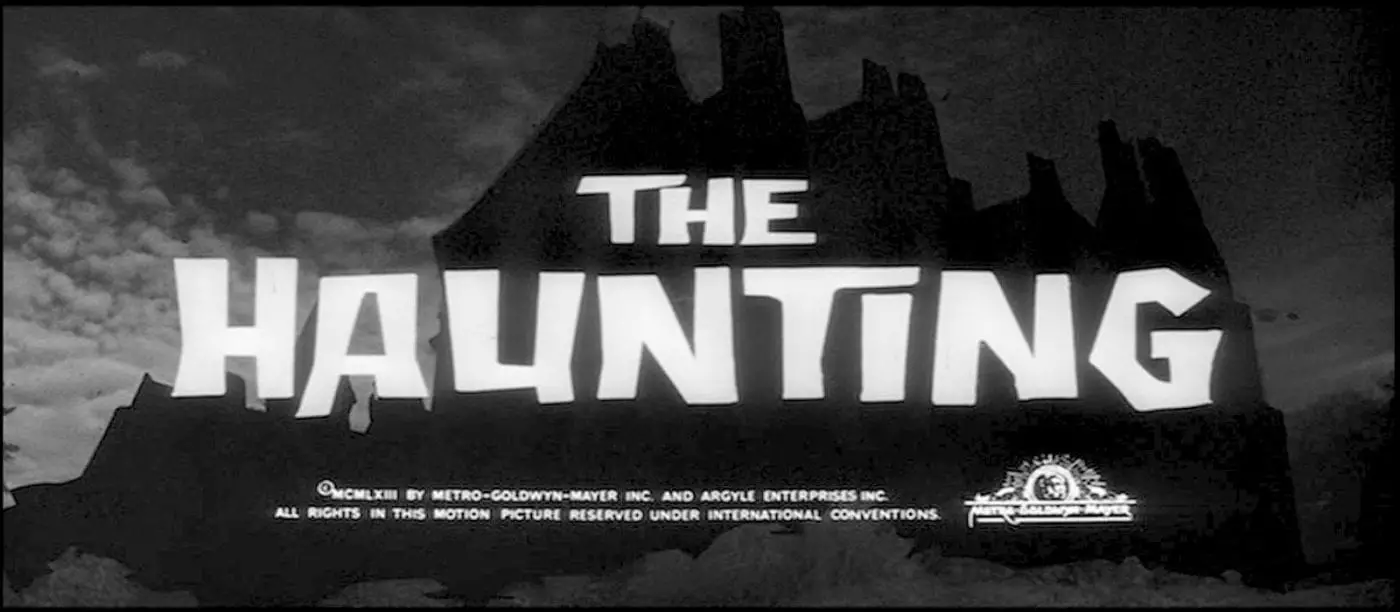
What truly attracted Medak to the film, though, was his reading of Nelson Gidding’s screenplay for 1963’s The Haunting directed by Robert Wise. Medak says he was “desperate” to get a position on that film but that he did not. Still, he was shooting on The V.I.P.’s with Elizabeth Taylor and Richard Burton just next to the project on the lot and spent a lot of time on the set. We don’t want to ignore Joel Michael’s contributions to the commentary, though, because he tells us a lot. He does exclaim that while the film often gets lumped into the horror film genre, he objects to that notion. At minute 26:30, David Gregory brings up a fascination of his with the protagonist that addresses a complaint we also heard from Ebert. It is that the protagonist is not one to be scared, that he will not run away. He says that he is a character who will remain skeptical, but that helps the audience worry for him in a way that he doesn’t for himself. Michaels’s reply to that is that he does start believing once he begins to believe it is his daughter reaching out with the red ball. It is why he won’t leave the house. He becomes an investigator who then uncovers a crime. The last point I’ll leave here regards the famous séance scene and the originality of the automatic writing. Michaels credits all of it to the research of their writers.
“The Music of The Changeling” – Interview with Music Arranger Kenneth Wannberg
Twin Peaks fans, if you love watching composer Angelo Badalamenti’s special features, this one with Ken Wannberg is for you. For the rest of you, this should go without saying. We get to see Wannberg play a gorgeous excerpted portion of the film’s theme, which those who purchase a limited edition of the Blu-ray will receive on the soundtrack as an additional disc in the set. Wannberg tells stories of working with John Williams on their first film together, Valley of the Dolls, as well as on Star Wars. At minute 3:15, he also informs us from his memory that The Changeling initially had a different title that he remembers as The House on Cherry Street, which he was told was based on a true story.
Master of Horror Mick Garris on The Changeling
At a length of five minutes and thirty seconds, it is always a great pleasure to listen to Mick Garris. Please see his podcast episode, wherein he interviews Peter Medak at length. In this brief feature, he explains that he always loved how adult the film was, that he also loves how emotional it is for a horror film, that it is soaked in emotional over physical pain. A last note I made from this regarding horror-related films including the pain of loss is where Garris admits that Don’t Look Now is more experimental, while The Changeling feels much more personal.
The Psychotronic Tourist – The Changeling
From what I gather, The Psychotronic Tourist is a series produced and presented by Severin Films for their releases where set locations are visited quickly for audiences accompanied by facts about the area and what it is today. The host explains that they re-visit iconic and not-so-iconic film locations. This episode is, of course, about locations from The Changeling. I appreciated that they point out that a trope in these horror films is of devastated persons moving alone into large empty homes to which we would otherwise ask “why?” She states that the emptiness and echoes of these spaces reflect the emptiness inside of them. They visit several of the sites. A highlight I would like to note is their third visit to Sea-tac airport, which has appeared in The Rockford Files and in Sleepless in Seattle, but it’s most infamous visitor was D.B. Cooper, who made a temporary landing there before his famous theft. Twin Peaks fans will recognize the name and instance as the one which inspired Mark Frost and David Lynch in the naming of FBI Special Agent Dale Cooper.
The Remake
It is without surprise that a remake of The Changeling is now underway. Be sure to hear the commentary on this edition as you will hear Joel Michael’s passion and pride for this film as he is set to produce the remake. That can set us somewhat at ease. Peter Medak is fully aware of the project and is excited about it as well, which also makes him only more proud of this release. It is my understanding that they hoped he would join the new project but that he is happy to pass that mantle with full confidence in his own version. There will be some changes. The remake will move from the U.S. to Venice, Italy, which makes anyone who has seen Don’t Look Now shudder at least a little. If you would like to hear a good explanation of how Venice can affect a horror film’s mood, hear the linked podcast covering Don’t Look Now by Wyrd Signal. The protagonist in this film will be a musician by the name of Joe Carmichael who returns to his childhood home in Italy only to find it haunted. The remake will be by Cornerstone Films. Mark Steven Johnson will write and direct with production set to begin in 2019. Until then, this Severin Films or Second Sight edition is the one for you.
If you have managed to read this far, thank you. Overall, I’m biased, but I cannot help but think if you are new to it and horror is or maybe has never been your genre, this is the movie that you have been waiting too long for. I hope that you engage with this gorgeous new edition and that maybe together, we can all begin to start a new tradition, not unlike Abilene’s, of house party viewings with our red rubber balls set at the tops of our stairs, waiting for it to drop. Yes, you can purchase your very own novelty ball by itself.
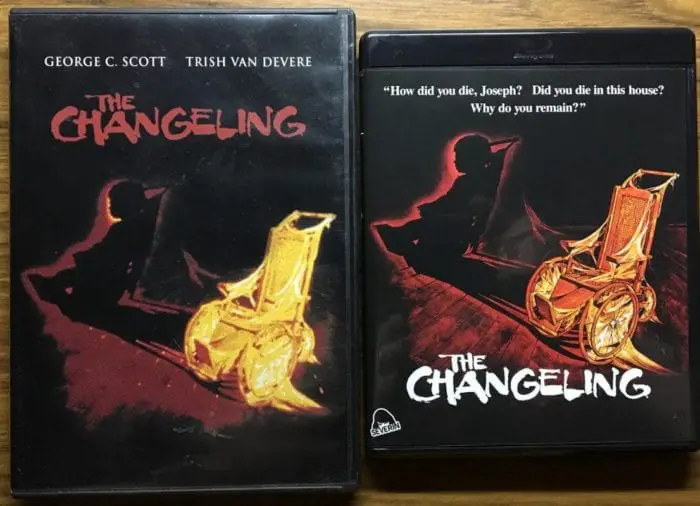
[Note: Multiple sources are stating that the Blu-ray includes a defect in the 5.1 audio track. It is missing a short clip of dialogue. By all reports, the 2.0 stereo sound includes all of the dialogue. This can be found in the main menu option under “Set Up.” The default audio setting is 5.1.]
[1] Cooks, Brandon. “Businesses offers scary, safe events for town.” The Optimist. October 26, 2006. Retrieved on July 7, 2018 from https://issuu.com/jmcnetwork/docs/2006-10-27
[2] Nerd Herder. “Nerd Herder’s Top Five Halloween Movies.” Minced Meat Pie. October 15, 2018, Retrieved on July 7, 2018 from http://mincedpie.com/2016/10/15/nerd-herders-top-five-halloween-movies/
[3] Brazman. “Scariest movie you’ve ever seen?” Texas Bowhunter.com. April 6, 2018. Retrieved on July 7, 2018 from http://discussions.texasbowhunter.com/forums/showthread.php?p=13298376#post13298376
[4] Vincent, Canby. “Movie: ‘The Changeling’: Haunted in Seattle.” New York Times (1923-Current file); Mar 28, 1980; ProQuest Historical Newspapers: The New York Times, pg. C8.
[5] Ebert, Roger. “The Changeling.” RogerEbert.com, April 2, 1980. Retrieved on July 9, 2018 from https://www.rogerebert.com/reviews/the-changeling-1980
[6] Locker, Melissa. “Is ‘The Changeling’ the scariest movie ever?” IFC. March 29, 2012. Retrieved on July 9, 2018 from https://www.ifc.com
[7] Stephen Graham Jones, introduction to Burnt Offerings, by Robert Marasco, (Richmond, VA : Valancourt Books, 2015).
[8] Dorwart, Jason. “The Incorporeal Corpse: Disability, Liminality, Performance,” (Ph.D diss., University of California, San Diego, 2017), 125.
[9] Andrade, Pilar. “Cinema’s Doubles, Their Meaning, and Literary Intertexts,” CLCWeb: Comparative Literature and Culture 10, no. 4 (2008): 6.
[10] Scahill, Andrew. The Revolting Child in Horror Cinema : Youth Rebellion and Queer Spectatorship, Palgrave Macmillan, 2015. ProQuest Ebook Central, http://ebookcentral.proquest.com/lib/ttu/detail.action?docID=4009201
[11] Rudolph, Katie. “A Denver House That Inspired a Horror Film,” Denver Public Library, October 22, 2013. Retrieved on July 27, 2018 from https://history.denverlibrary.org/news/denver-house-inspired-horror-film

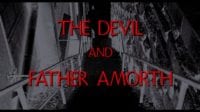

First of all, awesome job on the article. I’m an avid life long horror fanatic who puts The Changeling as my number 1 favorite horror film ever. I first seen the film back when I was about 12 years old and was creeped out. But it was the look and feel of the film that stuck with me. Not to mention fantastic performances from the cast collectively. Oh and the music is straight up iconic. Of course it’s not at the level of the Halloween theme song lol BUT the Changeling music is the secret scare weapon. I loath the whole remake sickness that’s taken hollywood by storm. But I’m stoked about the remake for this gem. Very interested in the retelling without giving disrespect to the original film. Think I’ll pop in the Changeling right now. Keep up the awesome work! Cheers!!